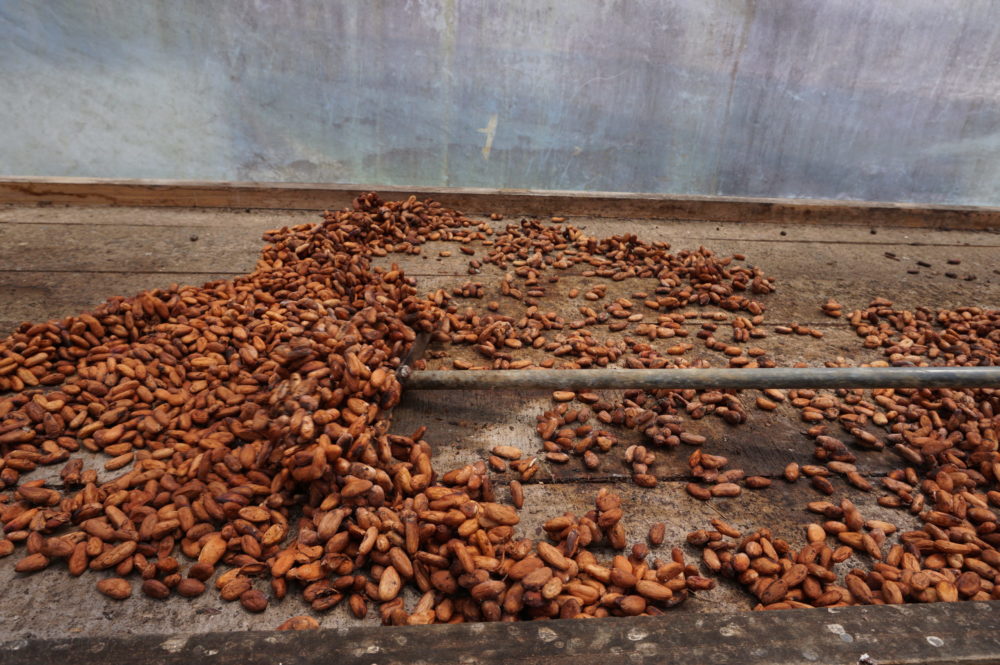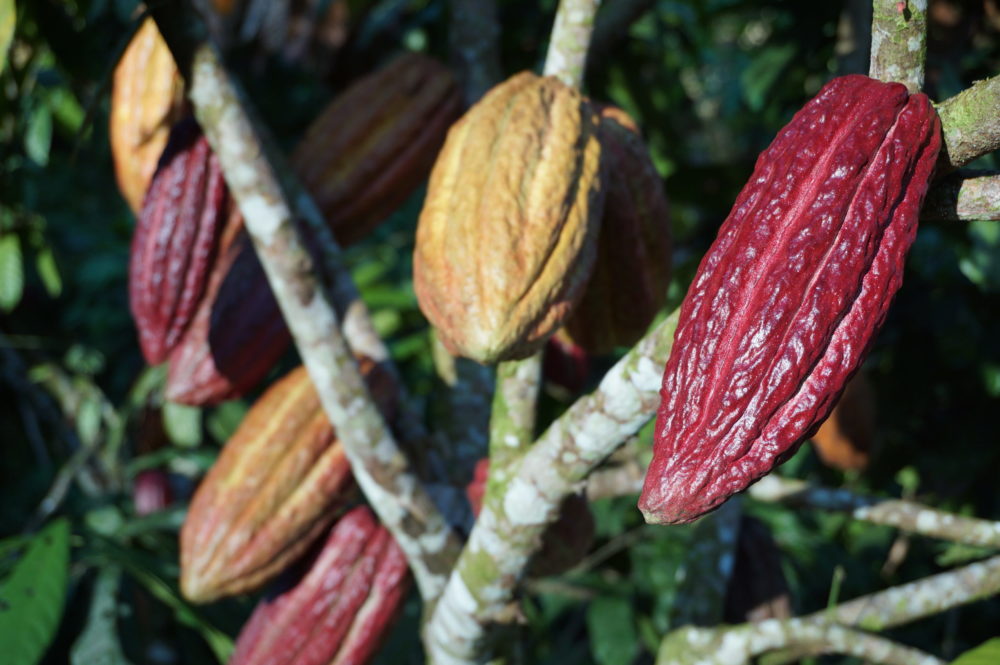Chocolate is made from cocoa beans, i.e. the seeds of the cocoa tree. Cocoa trees originally come from the Amazon region and have been cultivated in many Latin American countries for around 5,000 years. Today there is a kind of cocoa belt that stretches around the world. Farmers in equatorial countries around the world now grow cocoa, almost 70% in Ivory Coast and Ghana alone. If you want to learn more about cocoa cultivation, read on here .
A cacao tree produces thousands of flowers each year. The flowers are tiny and grow directly on the stem. In order for the blossom to become a plump cocoa pod one day, it has to be pollinated. Sounds like a lot of cocoa beans? Unfortunately not, because pollinating cocoa blossoms is a major challenge. In many regions, only about 10-20% of a cocoa tree's blossoms are actually pollinated. About 80-90% of the flowers receive either insufficient or no pollen to form cocoa pods. This is mainly because cocoa trees cannot pollinate themselves. But how does pollination work?
 Cocoa flowers cannot pollinate themselves. They are so tiny that only very small insects like mosquitoes can reach their pollen. © Björn S. via Wikimedia Commons (CC BY-SA 3.0)
Cocoa flowers cannot pollinate themselves. They are so tiny that only very small insects like mosquitoes can reach their pollen. © Björn S. via Wikimedia Commons (CC BY-SA 3.0)
Unlike the rest of the world, where mosquitoes are dealt with with fly swatters, in cocoa-growing regions they are seen as important "companions" in increasing yields. At the same time, a 2019 study by the American Society for Horticultural Science examined whether artificial or manual pollination could increase yields. The results were amazing: yields could be more than doubled . And this is where – as is so often the case – the fact comes into play that wild cocoa cultivation in particular is practically unexplored. Because while researchers on cocoa plantations primarily research pollination by mosquitoes, research into pollination of wild cocoa is completely ignored. A study from 2016 suggests that other insects may also play an important role in cocoa pollination. So if you are annoyed by mosquitoes and other insects again next summer, always remember that their relatives might be working on the next bar of chocolate right now ;-)
 A male Forcipomyia mosquito © Christophe Quintin via Flickr (CC BY-NC 2.0)
A male Forcipomyia mosquito © Christophe Quintin via Flickr (CC BY-NC 2.0)
The longer answer: Mosquitoes aren't just important for making chocolate. Despite their annoying nature, they are an important part of the ecosystem! And that makes them – ultimately – also important for us humans. Mosquitoes are an important part of the diet for many animal species. But not only that: mosquito larvae grow in streams and rivers, which has many great side effects. They purify the water, release nitrogen for plants through their metabolism and are a useful food for fish!
mass instead of class
A cacao tree produces thousands of flowers each year. The flowers are tiny and grow directly on the stem. In order for the blossom to become a plump cocoa pod one day, it has to be pollinated. Sounds like a lot of cocoa beans? Unfortunately not, because pollinating cocoa blossoms is a major challenge. In many regions, only about 10-20% of a cocoa tree's blossoms are actually pollinated. About 80-90% of the flowers receive either insufficient or no pollen to form cocoa pods. This is mainly because cocoa trees cannot pollinate themselves. But how does pollination work? Cocoa flowers cannot pollinate themselves. They are so tiny that only very small insects like mosquitoes can reach their pollen. © Björn S. via Wikimedia Commons (CC BY-SA 3.0)
Cocoa flowers cannot pollinate themselves. They are so tiny that only very small insects like mosquitoes can reach their pollen. © Björn S. via Wikimedia Commons (CC BY-SA 3.0)Of mosquitoes and flowers
Gall midges (from the Cecidomyiidae family) and also mosquitoes (from the Ceratopogonidae family) are among the most important pollinators for cocoa trees. Your biggest advantage? Due to their tiny size - between 1 and 3 millimeters - they fit perfectly through the small flower heads of the cacao trees . They take the pollen from the male part of a flower on one tree and transfer it to the female part of a flower on another tree. And as if that wasn't difficult enough, the mosquitoes are also under time pressure: the cocoa blossoms are usually only receptive to pollen for 1-2 days. According to entomologists, the flowers must be pollinated within 36 hours or they will die.Unlike the rest of the world, where mosquitoes are dealt with with fly swatters, in cocoa-growing regions they are seen as important "companions" in increasing yields. At the same time, a 2019 study by the American Society for Horticultural Science examined whether artificial or manual pollination could increase yields. The results were amazing: yields could be more than doubled . And this is where – as is so often the case – the fact comes into play that wild cocoa cultivation in particular is practically unexplored. Because while researchers on cocoa plantations primarily research pollination by mosquitoes, research into pollination of wild cocoa is completely ignored. A study from 2016 suggests that other insects may also play an important role in cocoa pollination. So if you are annoyed by mosquitoes and other insects again next summer, always remember that their relatives might be working on the next bar of chocolate right now ;-)
 A male Forcipomyia mosquito © Christophe Quintin via Flickr (CC BY-NC 2.0)
A male Forcipomyia mosquito © Christophe Quintin via Flickr (CC BY-NC 2.0)So what if there were no more mosquitoes?
The short answer: there would be less chocolate!The longer answer: Mosquitoes aren't just important for making chocolate. Despite their annoying nature, they are an important part of the ecosystem! And that makes them – ultimately – also important for us humans. Mosquitoes are an important part of the diet for many animal species. But not only that: mosquito larvae grow in streams and rivers, which has many great side effects. They purify the water, release nitrogen for plants through their metabolism and are a useful food for fish!



